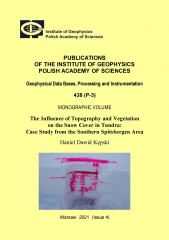- A - Physics of the Earth's Interior
- B - Seismology
-
C - Geomagnetism
C-119, C-118, C-117, C-116, C-115, C-114, C-113, C-112, C-111, C-110, C-109, C-108, C-107, C-106, C-105, C-104, C-103, C-102, C-101, C-100, C-99, C-98, C-97, C-96, C-95, C-94, C-93, C-92, C-91, C-90, C-89, C-88, C-87, C-86, C-85, C-84, C-83, C-82, C-81, C-80, C-79, C-78, C-77, C-76, C-75, C-74, C-73, C-72, C-71, C-70, C-69, C-68, C-67, C-66, C-65, C-64, C-63, C-62, C-61, C-60, C-59, C-58, C-57, C-56, C-55, C-54, C-53, C-52, C-51, C-50, C-49, C-48, C-47, C-46, C-45, C-44, C-43, C-42, C-41, C-40, C-39, C-38, C-37, C-36, C-35, C-33, C-32, C-31, C-30, C-29, C-28, C-27, C-26, C-25, C-24, C-23, C-22, C-21, C-20, C-19, C-18, C-17, C-16, C-15, C-14, C-13, C-12, C-11, C-10, C-9, C-8, C-7, C-6, C-5, C-4, C-3, C-2, C-1
-
D - Physics of the Atmosphere
D-79, D-78, D-77, D-76, D-75, D-74, D-73, D-72, D-71, D-70, D-69, D-68, D-67, D-66, D-65, D-64, D-63, D-62, D-61, D-60, D-59, D-58, D-57, D-56, D-55, D-54, D-53, D-52, D-51, D-50, D-49, D-48, D-47, D-46, D-44, D-45, D-43, D-42, D-41, D-40, D-39, D-38, D-37, D-35, D-34, D-33, D-32, D-31, D-30, D-28, D-27, D-26, D-25, D-24, D-23, D-22, D-21, D-20, D-19, D-18, D-17, D-16, D-15, D-14, D-13, D-12, D-11, D-10, D-9, D-8, D-7, D-6, D-5, D-4, D-3, D-2, D-1
- E - Hydrology
- P - Polar Research
- M - Miscellanea
-
Online First
The Influence of Topography and Vegetation on the Snow Cover in Tundra: Case Study from the Southern Spitsbergen Area
Volume: 438
Series: P-3
DOI: 10.25171/InstGeoph_PAS_Publs-2021-041
The aim of the study was to identify the snow cover distribution in the southern Spitsbergen tundra environment and to quantify its relationship with the topography and land cover. This was achieved by correlating vectorized cartographic materials, modeled climatic parameters and calculated topographic indices with snow cover properties measured in the field and obtained using remote sensing techniques. An important source of information used in the analyzes was time-lapse photography, which, thanks to the developed methodology and created tools, allowed to obtain snow cover extent data characterized by high temporal and spatial resolution. Snow cover distribution in the immediate vicinity of the Polish Polar Station obtained from time-lapse material was related to the results of satellite image classification from the 2014 ablation season. The field data was used to validate the SNOWPACK (predicting snow cover structure) and Alpine3D (predicting snow spatial distribution) models developed by SLF-WSL. They were implemented for the first time in the tundra environment of Svalbard. The models were also used to simulate snow conditions in the vicinity of the Polish Polar Station at the end of the twenty-first century. For this purpose, data from climate projections of the Polar CORDEX initiative were adopted. The worst-case climate change scenario (RCP8.5) was assumed.
MONOGRAPHIC VOLUME
C O N T E N T S
Editorial note, ...3
Acknowledgements, ...4
List of symbols and abbreviations, ...5
Abstract, ...6
Streszczenie, ...7
1. Introduction, ...9
2. Aim and scope of the study, ...9
3. Study area, ...10
3.1 Relief and land coverage, ...11
3.2 Cliumate, ...13
3.2.1 Selected meteorological parameters on PPS Hornsund, ...14
3.2.2 Spatial distribution of meteorological parameters, ...21
3.2.3 Snow cover at PPS Hornsund meteorological site, ........................................... 27
4. Snow cover of Svalbard tundra areas in the light of literature, ............................................ 33
4.1 Snow cover relationship with land cover and relief, .................................................. 33
4.2 History of snow reseach at Svalbard, with particular attention to the Hornsund Fiord area, ...34
4.2.1 Studies from the vicinity of the Polish Polar Station, ...34
4.2.2 Research from other parts of Spitsbergen, ...35
5. Data and methods, ...36
5.1 Fieldwork, ...37
5.2 Remote sensing data, ...40
5.2.1 Time-lapse photography, ...40
5.2.2. Satelite imagery, ...47
5.2.3 Topographical indices, ...50
5.3 Snow stratigraphy representation in SNOWPACK Model, ...51
5.4 Spatially distributed snow model Alpine3D, ...54
6. Spatial and temporal variability of snow cover in the neighbourhood of polish polar station, ...58
6.1 Pattern of snow cover dissappearance in Fluglebekken catchment, ...58
6.2 Variability of snow cover on different land coverage types, ...68
6.3 Snow cover relationships with terrain, ...73
6.4 Result of snow cover distribution model, ...77
7. Spatial variability of snow cover on the tundra in the surroundings of the Hornsund Fiord, ...80
7.1. Pattern of snow cover disappearance on the coasts of the Hornsund Fiord, ...80
7.2 Spatial distribution of the snow cover and its properties, ...84
7.3 Snow cover relationships with topography and meteorological conditions, ...88
8. Dynamics of changes in snowpack stratigraphy on various land cover types, ...91
9. Forecast of snow conditions in the area of the Polish Polar Station at the end of the twenty-first century, ...100
10. Discussion, ...105
11. Summary and conclusions, ...108
Appendix, ...112
References, ...113


